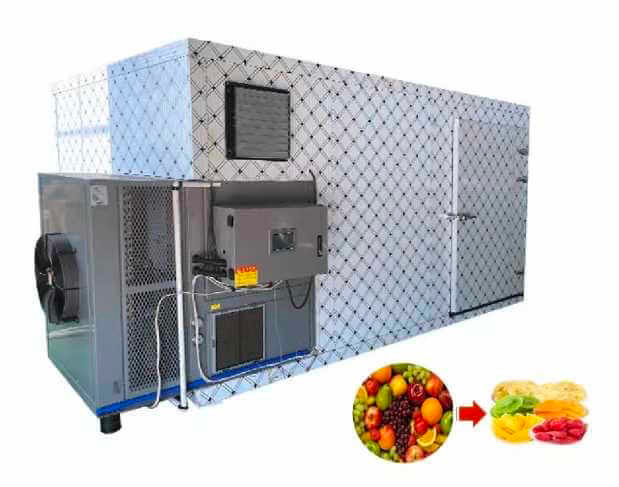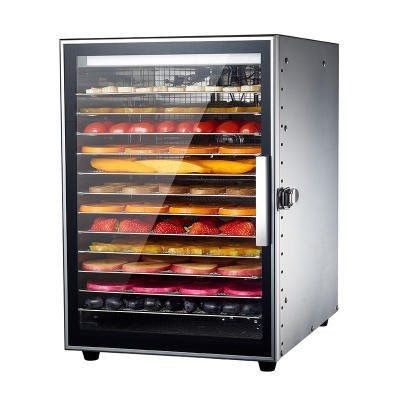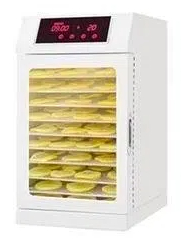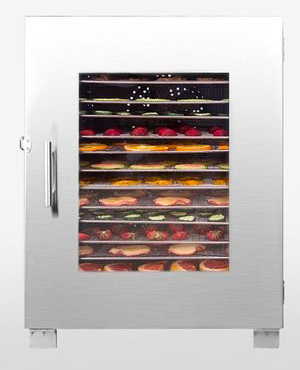
Content Menu
● Introduction
● Understanding Food Drying Technologies
>> What Is a Heat Pump Dryer?
>> What Is a Condenser Dryer?
● Heat Pump vs. Condenser Dryer: Key Differences
● Advantages of Heat Pump Dryers
>> Energy Efficiency
>> Cost-Effectiveness Over Time
>> Versatility
>> Preservation of Nutritional Value
● Disadvantages of Heat Pump Dryers
>> Initial Investment
>> Longer Drying Times
● Advantages of Condenser Dryers
>> Lower Initial Cost
>> Faster Drying Times
>> Simplicity of Operation
● Disadvantages of Condenser Dryers
>> Higher Energy Consumption
>> Less Precise Temperature Control
● Choosing the Right Dryer for Your Needs
● Maintenance Considerations for Food Dryers
● Industry Trends in Food Drying Technology
● Conclusion
● Frequently Asked Questions
>> 1. What is the main difference between heat pump and condenser dryers?
>> 2. Are heat pump dryers worth the investment?
>> 3. Can I use a heat pump dryer for all types of food?
>> 4. How do I maintain my food dryer?
>> 5. What factors should I consider when choosing a dryer?
Introduction
In the world of food processing, the choice of drying equipment is crucial. As a Chinese manufacturer specializing in food drying machines, we understand the importance of selecting the right technology for your needs. This article will explore the differences between heat pump dryers and condenser dryers, focusing on their efficiency, cost-effectiveness, and overall performance. We will also provide insights into how our OEM services can help brands and wholesalers meet their specific requirements.

Understanding Food Drying Technologies
What Is a Heat Pump Dryer?
A heat pump dryer uses a refrigeration cycle to remove moisture from food products. It operates by extracting heat from the air and transferring it to the drying chamber. This method is energy-efficient and allows for precise temperature control, making it ideal for sensitive food items. Heat pump dryers can maintain lower temperatures while still effectively drying products, which helps to preserve flavor, color, and nutritional value.
What Is a Condenser Dryer?
Condenser dryers, on the other hand, work by heating air and passing it through the product to evaporate moisture. The moisture-laden air is then condensed back into water, which is collected in a tank or drained away. While effective, this method tends to consume more energy compared to heat pump dryers. The higher temperatures used in condenser dryers can also lead to potential quality loss in delicate food items.
Heat Pump vs. Condenser Dryer: Key Differences
| Feature | Heat Pump Dryer | Condenser Dryer |
|-----------------------------|-------------------------------------|-----------------------------------|
| Energy Efficiency | High | Moderate |
| Initial Cost | Higher | Lower |
| Operating Cost | Lower | Higher |
| Temperature Control | Precise | Less precise |
| Environmental Impact | Lower carbon footprint | Higher carbon footprint |
Advantages of Heat Pump Dryers
Energy Efficiency
One of the most significant advantages of heat pump dryers is their energy efficiency. They can operate at lower temperatures while still effectively removing moisture from food products. This not only saves energy but also helps preserve the quality of the food being dried. For businesses looking to reduce their carbon footprint and energy costs, heat pump dryers are an excellent choice.
Cost-Effectiveness Over Time
While heat pump dryers may have a higher initial cost compared to condenser models, they often lead to lower operating costs. Over time, the savings on energy bills can offset the initial investment. This long-term cost-effectiveness makes heat pump dryers an attractive option for many food processing businesses.
Versatility
Heat pump dryers are versatile and can be used for various types of food products, including fruits, vegetables, and meats. Their ability to maintain low temperatures makes them suitable for drying delicate items without compromising quality. This versatility allows businesses to expand their product offerings without needing multiple drying machines.
Preservation of Nutritional Value
Another significant advantage of heat pump technology is its ability to preserve the nutritional value of food products. By operating at lower temperatures and reducing exposure to high heat, these dryers help retain vitamins and minerals that might otherwise be lost during traditional drying processes.

Disadvantages of Heat Pump Dryers
Initial Investment
The primary drawback of heat pump dryers is their higher upfront cost. For businesses with limited budgets, this can be a significant consideration. However, it's essential to weigh this initial investment against potential long-term savings in energy costs.
Longer Drying Times
Heat pump dryers may take longer to dry products compared to condenser dryers due to their lower operating temperatures. However, this can be mitigated by optimizing the drying process through proper airflow management and load sizing.
Advantages of Condenser Dryers
Lower Initial Cost
Condenser dryers generally have a lower purchase price than heat pump models, making them more accessible for small businesses or startups. This affordability can be appealing for those just entering the food processing industry.
Faster Drying Times
For certain applications, condenser dryers can achieve faster drying times due to their higher operating temperatures. This can be beneficial for businesses looking to increase throughput and reduce turnaround times on production schedules.
Simplicity of Operation
Condenser dryers are often simpler in design and operation compared to heat pump models. This simplicity can lead to easier maintenance and operation for staff who may not have extensive training in advanced drying technologies.
Disadvantages of Condenser Dryers
Higher Energy Consumption
Condenser dryers tend to consume more energy than heat pump dryers, which can lead to higher operational costs over time. For businesses aiming for sustainability or those with tight profit margins, this increased energy use can be a significant drawback.
Less Precise Temperature Control
The temperature control in condenser dryers is less precise compared to heat pump models, which may affect the quality of sensitive food products. Inconsistent temperatures can lead to uneven drying or even cooking of certain foods.
Choosing the Right Dryer for Your Needs
When deciding between a heat pump dryer and a condenser dryer for your food processing business, consider the following factors:
- Type of Food Products: If you are dealing with delicate items like herbs or fruits that require careful handling, a heat pump dryer may be more suitable.
- Budget: Evaluate your budget for both initial investment and ongoing operational costs.
- Production Volume: Consider your production volume and how quickly you need to dry products.
- Energy Efficiency Goals: If sustainability is a priority for your business, heat pump dryers offer lower energy consumption and environmental impact.
- Space Requirements: Assess your facility's space constraints as some models may require more room for installation and operation.
Maintenance Considerations for Food Dryers
Proper maintenance is essential for ensuring the longevity and efficiency of your food drying equipment. Here are some key maintenance tips:
1. Regular Cleaning: Keep filters clean and free from debris to ensure optimal airflow.
2. Check Seals: Inspect door seals regularly for wear and tear; damaged seals can lead to energy loss.
3. Monitor Performance: Keep track of drying times and product quality; any significant changes may indicate maintenance issues.
4. Professional Servicing: Schedule regular professional servicing for thorough inspections and repairs as needed.
5. User Training: Ensure that staff are trained on proper operation techniques to minimize wear on equipment.
By following these maintenance tips, you can extend the lifespan of your dryer while maximizing its performance.
Industry Trends in Food Drying Technology
As technology continues to evolve, several trends are shaping the future of food drying:
- Automation: Many manufacturers are incorporating automation into their drying processes to improve efficiency and reduce labor costs.
- Smart Technology: Integration of IoT (Internet of Things) technology allows for remote monitoring and control of drying equipment.
- Sustainability Focus: There is an increasing emphasis on sustainable practices within the food industry; energy-efficient equipment like heat pump dryers aligns well with these goals.
- Research & Development: Ongoing research into new materials and technologies aims to improve drying efficiency while maintaining product quality.
These trends indicate that investing in modern drying technology not only enhances operational efficiency but also supports broader industry goals related to sustainability and innovation.
Conclusion
In conclusion, both heat pump and condenser dryers have their advantages and disadvantages when it comes to food drying applications. Heat pump dryers are generally more energy-efficient and better suited for delicate products but come with a higher initial cost. Conversely, condenser dryers are more affordable upfront but may lead to higher operational costs due to increased energy consumption.
As a leading manufacturer of food drying machines in China, we offer OEM services tailored to your specific needs. Whether you choose a heat pump or condenser dryer, our expertise can help you find the right solution for your business.

Frequently Asked Questions
1. What is the main difference between heat pump and condenser dryers?
The main difference lies in their operation; heat pump dryers use a refrigeration cycle for moisture removal at lower temperatures, while condenser dryers use heated air that condenses moisture back into water.
2. Are heat pump dryers worth the investment?
Yes, while they have a higher initial cost, they offer significant savings in energy consumption over time.
3. Can I use a heat pump dryer for all types of food?
Yes, heat pump dryers are versatile and suitable for various food types including fruits, vegetables, and meats.
4. How do I maintain my food dryer?
Regular maintenance includes cleaning filters, checking seals, and ensuring proper airflow around the unit.
5. What factors should I consider when choosing a dryer?
Consider factors such as type of food products, budget constraints, production volume requirements, and energy efficiency goals when selecting a dryer type.
By understanding these aspects thoroughly and choosing wisely between heat pump vs condenser dryer options based on your specific needs—whether through our OEM services or direct purchases—you'll be well-equipped to enhance your food processing operations effectively!












